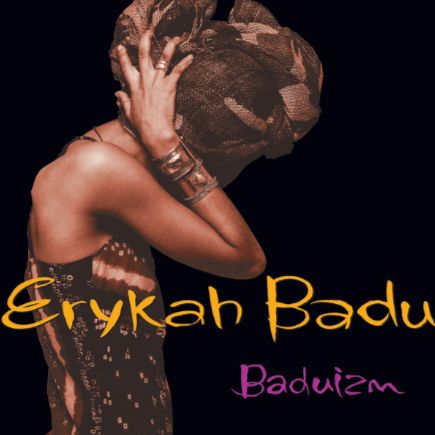Erykah Badu: l’héritière libre de la néo-soul et de l’esprit du jazz
Chanteuse, autrice-compositrice et performeuse visionnaire, Erykah Badu, née Erica Abi Wright, émerge à la fin des années 1990 comme une figure centrale de la néo-soul, un courant hybride mêlant soul, jazz, hip-hop et funk. Son premier album Baduizm (1997), salué comme un tournant dans l’histoire des musiques afro-américaines, remporte un succès critique et commercial fulgurant (triple disque de platine). Il est suivi, la même année, de Live (double disque de platine), qui assoit sa réputation d’artiste complète et la consacre, dès ses débuts, comme la “Queen of Neo Soul.”
Baduizm et son single phare On & On lui valent ses premières récompenses aux Grammy Awards : meilleure performance vocale R&B féminine et meilleur album R&B. Avec sa voix chaude, son phrasé souple aux inflexions jazz, et sa manière de raconter, entre spiritualité et introspection, Erykah Badu s’inscrit dans une tradition portée par les grandes chanteuses de jazz, tout en réinventant ses codes.
Formée à la Booker T. Washington High School for the Performing and Visual Arts, puis brièvement étudiante en théâtre à la Grambling State University, Badu quitte l’université en 1993 pour se consacrer à la musique. Son travail puise dans les rythmes syncopés, les formats libres, les expérimentations sonores — une démarche qui la rapproche des figures tutélaires du jazz comme Miles Davis ou John Coltrane.
Avec Mama’s Gun (2000), elle signe un album plus organique, ancré dans la continuité du jazz et du groove. Worldwide Underground (2003), orienté vers l’improvisation et les longues jam sessions, révèle son goût pour les formes ouvertes. Les projets New Amerykah Part One (2008) et Part Two (2010), très bien reçus par la critique, approfondissent une démarche à la fois politique, poétique et sonore.
Libre, audacieuse, insaisissable, Badu cultive aussi l’art de la provocation artistique. Sa vidéo Window Seat (2010), tournée sans autorisation en une seule prise dans les rues de Dallas, sur les lieux de l’assassinat de JFK, interroge frontalement la vulnérabilité, la liberté et l’acte de création dans l’espace public. Comme les jazzmen qu’elle admire, elle joue avec les formes, déconstruit les attentes et transforme la performance en acte de résistance.
Erykah Badu: la heredera libre del neo-soul y del espíritu del jazz
Cantante, compositora e intérprete visionaria, Erykah Badu, nacida Erica Abi Wright, emergió a finales de los años noventa como una figura central del neo-soul, un género híbrido que mezcla soul, jazz, hip-hop y funk. Su primer álbum, Baduizm (1997), celebrado como un punto de inflexión en la historia de la música afroamericana, fue un éxito fulgurante tanto de crítica como de público (triple disco de platino). Ese mismo año publicó Live (doble disco de platino), consolidando su reputación como artista completa y consagrándola desde sus inicios como la “Queen of Neo-Soul.”
Baduizm y su emblemático sencillo On & On le valieron sus primeros premios Grammy: mejor interpretación vocal femenina de R&B y mejor álbum de R&B. Con su voz cálida, su fraseo flexible con inflexiones jazzísticas y su forma de contar historias entre espiritualidad e introspección, Erykah Badu se inscribe en la tradición de las grandes cantantes de jazz, reinventando al mismo tiempo sus códigos.
Formada en la Booker T. Washington High School for the Performing and Visual Arts, y brevemente estudiante de teatro en la Grambling State University, Badu abandonó sus estudios en 1993 para dedicarse de lleno a la música. Su obra se alimenta de ritmos sincopados, estructuras libres y exploraciones sonoras — una aproximación cercana a la de figuras fundamentales del jazz como Miles Davis o John Coltrane.
Con Mama’s Gun (2000), presenta un álbum más orgánico, que mantiene la continuidad entre jazz y groove. Worldwide Underground (2003), centrado en la improvisación y las largas jam sessions, muestra su gusto por las formas abiertas. Los proyectos New Amerykah Part One (2008) y Part Two (2010), ampliamente elogiados por la crítica, profundizan en una búsqueda tanto política como poética y musical.
Libre, audaz e inasible, Badu también cultiva el arte de la provocación. Su video Window Seat (2010), rodado sin permiso en una sola toma por las calles de Dallas, en el lugar del asesinato de JFK, cuestiona de forma directa la vulnerabilidad, la libertad y el acto creativo en el espacio público. Como los grandes músicos de jazz que admira, juega con las formas, desafía las expectativas y convierte la performance en un acto de resistencia.
Erykah Badu: l’erede libera della neo-soul e dello spirito del jazz
Cantante, cantautrice e performer visionaria, Erykah Badu, nata Erica Abi Wright, si impone alla fine degli anni ’90 come figura centrale della neo-soul, un genere ibrido che fonde soul, jazz, hip-hop e funk. Il suo album d’esordio Baduizm (1997), acclamato come una svolta nella storia della musica afroamericana, ottiene un enorme successo di critica e pubblico (triplo disco di platino). Nello stesso anno pubblica Live (doppio disco di platino), che consolida la sua reputazione di artista completa e la consacra fin da subito come la “Queen of Neo Soul.”
Baduizm e il singolo di punta On & On le valgono i suoi primi Grammy Awards: miglior interpretazione vocale femminile R&B e miglior album R&B. Con la sua voce calda, il fraseggio fluido e venato di jazz, e la capacità di raccontare attraverso la spiritualità e l’introspezione, Erykah Badu si inserisce nella tradizione delle grandi cantanti jazz, pur reinventandone i codici.
Diplomata alla Booker T. Washington High School for the Performing and Visual Arts e brevemente iscritta a teatro presso la Grambling State University, Badu abbandona gli studi nel 1993 per dedicarsi completamente alla musica. La sua ricerca artistica si nutre di ritmi sincopati, strutture libere e sperimentazioni sonore — un approccio che la avvicina a figure come Miles Davis e John Coltrane.
Con Mama’s Gun (2000), realizza un album più organico, che mantiene la continuità tra jazz e groove. Worldwide Underground (2003), orientato all’improvvisazione e alle lunghe jam session, rivela il suo interesse per le forme aperte. I progetti New Amerykah Part One (2008) e Part Two (2010), acclamati dalla critica, approfondiscono una visione insieme politica, poetica e musicale.
Libera, audace e sfuggente, Badu coltiva anche l’arte della provocazione. Il video di Window Seat (2010), girato in un’unica ripresa senza autorizzazione per le strade di Dallas, sul luogo dell’assassinio di JFK, mette in discussione vulnerabilità, libertà e creazione artistica nello spazio pubblico. Come i jazzisti che ammira, Badu gioca con le forme, sovverte le aspettative e trasforma la performance in un atto di resistenza.
Erykah Badu: the free-spirited heir to neo-soul and the spirit of jazz
Singer, songwriter, and visionary performer Erykah Badu, born Erica Abi Wright, rose to prominence in the late 1990s as a central figure of the neo-soul movement — a hybrid genre blending soul, jazz, hip-hop, and funk. Her debut album Baduizm (1997), hailed as a turning point in African American music, achieved both critical and commercial success (triple platinum). It was followed the same year by Live (double platinum), solidifying her status as a fully formed artist and earning her the title “Queen of Neo Soul.”
Baduizm and its breakout single On & On earned Badu her first Grammy Awards: Best Female R&B Vocal Performance and Best R&B Album. With her warm voice, jazz-inflected phrasing, and storytelling infused with spirituality and introspection, Badu follows in the footsteps of great jazz vocalists while reinventing their legacy.
A graduate of Booker T. Washington High School for the Performing and Visual Arts, Badu briefly studied theater at Grambling State University before leaving in 1993 to focus entirely on music. Her creative work draws on syncopated rhythms, free structures, and sonic experimentation — an approach that echoes the legacy of jazz greats like Miles Davis and John Coltrane.
With Mama’s Gun (2000), she released a more organic-sounding album rooted in the intersection of jazz and groove. Worldwide Underground (2003), centered on improvisation and extended jam sessions, reveals her passion for open musical forms. The critically acclaimed New Amerykah Part One (2008) and Part Two (2010) deepen her exploration of music as political, poetic, and sonic expression.
Free, bold, and elusive, Badu also embraces artistic provocation. Her 2010 video Window Seat, filmed in a single take without permits on the streets of Dallas — on the site of JFK’s assassination — directly challenges ideas of vulnerability, freedom, and creative agency in public space. Like the jazz artists she admires, Badu plays with form, defies expectations, and turns performance into an act of resistance.



